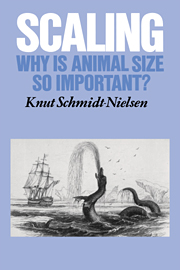Book contents
- Frontmatter
- Contents
- Preface
- 1 The size of living things
- 2 Problems of size and scale
- 3 The use of allometry
- 4 How to scale eggs
- 5 The strength of bones and skeletons
- 6 Metabolic rate and body size
- 7 Warm-blooded vertebrates: What do metabolic regression equations mean?
- 8 Organ size and tissue metabolism
- 9 How the lungs supply enough oxygen
- 10 Blood and gas transport
- 11 Heart and circulation
- 12 The meaning of time
- 13 Animal activity and metabolic scope
- 14 Moving on land: running and jumping
- 15 Swimming and flying
- 16 Body temperature and temperature regulation
- 17 Some important concepts
- Appendixes
- References
- Index
5 - The strength of bones and skeletons
Published online by Cambridge University Press: 05 June 2012
- Frontmatter
- Contents
- Preface
- 1 The size of living things
- 2 Problems of size and scale
- 3 The use of allometry
- 4 How to scale eggs
- 5 The strength of bones and skeletons
- 6 Metabolic rate and body size
- 7 Warm-blooded vertebrates: What do metabolic regression equations mean?
- 8 Organ size and tissue metabolism
- 9 How the lungs supply enough oxygen
- 10 Blood and gas transport
- 11 Heart and circulation
- 12 The meaning of time
- 13 Animal activity and metabolic scope
- 14 Moving on land: running and jumping
- 15 Swimming and flying
- 16 Body temperature and temperature regulation
- 17 Some important concepts
- Appendixes
- References
- Index
Summary
What skeletons do
Skeletons are support systems; they keep animals from collapsing, and they provide levers on which muscles can act. Skeletons are hard and mechanically rigid, and they can be either internal structures (endoskeletons, as in vertebrates, from fish to mammals) or external (exoskeletons, as in arthropods, from crabs to spiders and insects).
Skeletons are mechanical structures that must withstand the forces that impinge on them, or they fail. The skeleton must support the weight of the animal, or it will fail in compression by crushing. It must withstand the forces due to locomotion, which produce bending and torsion that may cause failure in buckling. Also, a skeleton must withstand the forces of impact, and this may be the most critical requirement.
A heavier skeleton will be stronger, and for animals that do not move about (corals, for example), most of the organism can consist of skeletal material. For animals that move about, a heavy skeleton increases the cost of moving about and also reduces agility and the chances of escape from predators. The size and structure of the skeleton will therefore involve a compromise between the various demands: What should be optimized, strength or lightness?
Scaling mammalian skeletons
Consider a group of vertebrates, mammals, for example, that are similarly organized, although they are not alike. It is familiar to all of us that the bones of an elephant are proportionately heavier and stockier than those of a mouse.
Information
- Type
- Chapter
- Information
- ScalingWhy is Animal Size so Important?, pp. 42 - 55Publisher: Cambridge University PressPrint publication year: 1984
Accessibility standard: Unknown
Why this information is here
This section outlines the accessibility features of this content - including support for screen readers, full keyboard navigation and high-contrast display options. This may not be relevant for you.Accessibility Information
- 2
- Cited by
